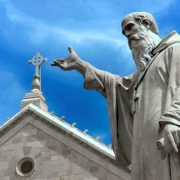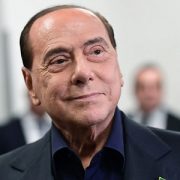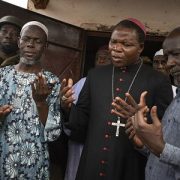My classroom is located between two statues, one of Gandhi and one of Confucius. To the north, about half a mile Gandhi’s stands in a corner of Union Square Park in southern Manhattan. Posed life-size and half hidden among some trees, Gandhi wears a loincloth of homespun khadi, otherwise he is naked, or half-naked as Churchill famously mocked. Feet on the ground, in full stride he grasps a walking stick in one hand eyeglasses in the other – perhaps suggesting determination and human frailty as well as connection to India’s toiling millions.
In Chinatown, a mile or so to the south, in a small square at the end of the Bowery, stands the statue of Confucius. He is posed motionless much larger than life, his height further augmented by the high pedestal under his feet Elaborately clothed in scholar’s garb, hands folded, he looms monumentally over the plaza, consuming and defining the space, emphasizing the importance of wise leadership and the human factor in society. There are no trees. Confucianism is not directly friendly to nature in the way Daoism is. If he were Chinese Gandhi would be a Daoist.
In class I tell my students to meditate on their place where the auras of the two men intersect maybe interact. Both were tragic figures, who died without fulfilling their life missions. In one of my courses on India, China, and Vietnam, I suggest that the students consider why China never produced a Gandhi as a revolutionary leader, nor India a Mao Zedong to lead its independence movement.
As for Confucius, well, he’s back, bigger than ever after long decades in the doghouse. He was first sent there in 1919 during the May 4 Movement, a student and worker uprising against the Versailles settlement for giving Japan territory belonging to China. Confucius represented at that time the old order of dynasties and emperors which the republican revolution of Sun Yat-sen had overthrown but not overcome. Confucius remained persona non for some time, enduring added disgrace when the Japanese invaders in the 1930s used his ideology (Mencius’ wang dao – kingly way) to justify their occupation.
In the course of the Communist revolution including the years after Japan’s defeat in 1945 Confucius remained confined to his inglorious quarters, until a new era of openness and progress began tentatively in the early 1970s, then in the late 70s with increasing momentum. By the 1980s Confucius had emerged from the ideological closet and today is a major figure in the Chinese pantheon; alongside what peers?
Well, in the center is China’s George Washington, a military and political founder of the modern nation, chairman of the Chinese Communist Party, Mao Zedong. Calling him all sorts of nasty names is sort of an ideological cottage industry in the west, mostly likening Mao to Hitler or China to German fascism, but inscrutably the Chinese take little notice and revere him in various ways, revere him more perhaps than they miss him, since revolutionary war is no picnic, a point Mao himself was wont to make.
The Chinese say things should never come in more than three (maybe because four si is a taboo number?). So with Confucius ensconced on the right, and Mao dead center, who is on the left. To round out the trio we have the father of the nation and the first great Chinese revolutionary, Sun Yat-sen himself. His presence on the Pantheon (or pedestal) serves several functions: it lengthens the revolutionary tradition, back to 1911 and even back to 1895 (first of Sun’s failed armed insurrections). In this way the Communist segment (starting from 1919 – May 4th movement and ending with the assumption of power in 1949) is extended – not only back in time, but forward too, as Sun was an early and prophetic advocate of policies that Deng Xiaoping executed: opening up to the world and developing economically (including inviting foreign aid and investment). Thus an extended time line of revolution contains (and limits or relativizes) the period of acute revolutionary violence and conflict, namely, resisting Japan and intense class struggle within China.
The figure of Sun also implies outreach to Taiwan and to Russia. The Chinese on Taiwan (if not the native Taiwanese) also revere Sun as the founder of the Nationalist GMD party led by Chiang Kai-shek until his death in 1975. Sun, who died in 1925, had made Chiang his successor. Furthermore, at the end of his life Sun, disgusted with the way western governments treated him and China, turned to the Soviet Union for moral and material support, and on Comintern advice oversaw the first united front (1924) of the Communists and the Nationalists. Confucius as icon also suggests outreach to Taiwan. The Nationalist Party has revered Confucius from its early days, and Chiang Kai-shek advertised himself as a Christian and a Confucian. Thus both Confucius and Sun have international significance, while Mao is strictly a domestic figure.
Another useful application of the Confucius icon is that he replaces the Maoist emphasis on class struggle and converging contradictions with a theory of social harmony, civil order, and education. Harmony without uniformity goes one of Confucius’ lines, a line the current leader Xi Jinping has used to underline China’s transition to civilized social order after a long period of all-consuming class struggle and fierce international conflict – against Japan and then the US.
Last October party leader Xi Jinping spoke to the 19th national congress of the Chinese Communist Party. It’s a complex review of the party’s history, its domestic and foreign battles. In a lengthy analysis of Xi’s thinking by Jiang Shigong, what caught my attention was the emphasis on integrating (another kind of harmony) the many contradictory aspects of the party’s history. Xi speaks of co-existing rather than antagonistic contradictions, giving a positive place to all factors and episodes even to negative ones: the period of intimate inter-action with the Soviet party, the contributions of the west to China, dramatic failures such as the Great Leap Forward (1969-61) and the Cultural Revolution are included, perhaps even reaffirmed, as essential if tragic components of the whole time line, though nowhere near so tragic as the losses China suffered in its wars against Japan and the US.
A favorite meme among some western-oriented Chinese and some western scholars is to pit Deng Xiaoping (in office 1978-89) against Mao, died 1976. Mao is denounced as a mad revolutionary who killed lots of people and ruined the economy, while Deng brought order and reconciliation with the US together with China’s entrance into the international world (the UN first of all). This commonplace view ignores the fact that Mao had orchestrated Nixon’s visit – 4 years before he died.
Xi Jinping rejects this favored western meme and credits both former leaders with making indispensable contributions, reminding all Chinese that without the revolution Mao led China would not be where it is today.
When Xi claims that socialism with Chinese characteristics is succeeding he puts the emphasis on Chinese characteristics rather than seeing China as but one variant of something greater called Socialism as initiated by the USSR. Xi blames Socialism’s failure in Russia on Khrushchev’s failed leadership, his revisions and capitulations to the west. For China Xi demands meritorious leadership, which is also the main aspiration of the Confucian Analects.






Nessun commento